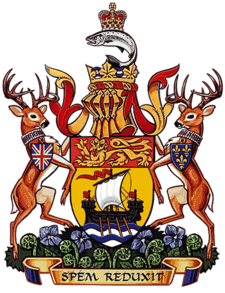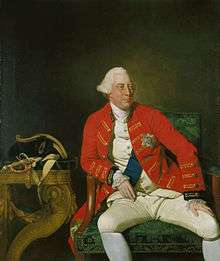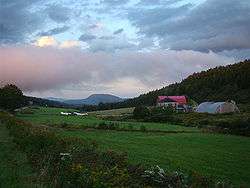Monarchy in New Brunswick
By the arrangements of the Canadian federation, Canada's monarchy operates in New Brunswick as the core of the province's Westminster-style parliamentary democracy.[1] As such, the Crown within New Brunswick's jurisdiction is referred to as the Crown in Right of New Brunswick,[2] Her Majesty in Right of New Brunswick,[3] or the Queen in Right of New Brunswick.[4] The Constitution Act, 1867, however, leaves many royal duties in New Brunswick specifically assigned to the sovereign's viceroy, the Lieutenant Governor of New Brunswick,[1] whose direct participation in governance is limited by the conventional stipulations of constitutional monarchy.[5]
| Queen in Right of New Brunswick | |
|---|---|
Provincial/State | |
 | |
| Incumbent | |
 | |
| Elizabeth II Queen of Canada since 6 February 1952 | |
| Details | |
| Style | Her Majesty |
| First monarch | Victoria |
| Formation | 1 July 1867 |
| Residence | Government House, Fredericton |
Constitutional monarchy in New Brunswick
The role of the Crown is both legal and practical; it functions in New Brunswick in the same way it does in all of Canada's other provinces, being the centre of a constitutional construct in which the institutions of government acting under the sovereign's authority share the power of the whole.[6] It is thus the foundation of the executive, legislative, and judicial branches of the province's government.[7] The Canadian monarch—since 6 February 1952, Queen Elizabeth II—is represented and her duties carried out by the Lieutenant Governor of New Brunswick, whose direct participation in governance is limited by the conventional stipulations of constitutional monarchy, with most related powers entrusted for exercise by the elected parliamentarians, the ministers of the Crown generally drawn from amongst them, and the judges and justices of the peace.[8] The Crown today primarily functions as a guarantor of continuous and stable governance and a nonpartisan safeguard against the abuse of power.[9][10] This arrangement began with the 1867 British North America Act,[1] and continued an unbroken line of monarchical government extending back to the early 16th century. However, though New Brunswick has a separate government headed by the Queen, as a province, New Brunswick is not itself a kingdom.[11]

Government House in Fredericton is owned by the sovereign only in her capacity as Queen in Right of New Brunswick and used as an official residence by both the lieutenant governor and the sovereign and other members of the Canadian Royal Family will reside there when in New Brunswick.[12]
Royal associations
Those in the Royal Family perform ceremonial duties when on a tour of the province; the royal persons do not receive any personal income for their service, only the costs associated with the exercise of these obligations are funded by both the Canadian and New Brunswick Crowns in their respective councils.[13] Monuments around New Brunswick mark some of those visits, while others honour a royal personage or event. Further, New Brunswick's monarchical status is illustrated by royal names applied to regions, communities, schools, and buildings, many of which may also have a specific history with a member or members of the Royal Family; New Brunswick itself is named in honour of King George III, who belonged to the House of Brunswick. Gifts are also sometimes offered from the people of New Brunswick to the royal person to mark a visit or an important milestone; for instance, Queen Elizabeth II was given in 1951 a pair of hand-woven car blankets made by the loom crofters of Gagetown and,[14] in 1976, a quilt hand-sewn by the Havelock United Baptist Church Ladies' Auxiliary.[15]
Associations also exist between the Crown and many private organizations within the province; these may have been founded by a Royal Charter, received a royal prefix, and/or been honoured with the patronage of a member of the Royal Family. Examples include the Royal New Brunswick Rifle Association, which received its royal prefix from Queen Elizabeth II in 1983. At the various levels of education within New Brunswick, there also exist a number of scholarships and academic awards either established by or named for members of the Royal Family, such as the Queen Elizabeth II Scholarship, set up by the government of New Brunswick to coincide with the visit of the Queen to the province in 1959.[16]
The main symbol of the monarchy is the sovereign herself, her image (in portrait or effigy) thus being used to signify government authority.[17] A royal cypher or crown may also illustrate the monarchy as the locus of authority, without referring to any specific monarch. Further, though the monarch does not form a part of the constitutions of New Brunswick's honours, they do stem from the Crown as the fount of honour, and so bear on the insignia symbols of the sovereign.
 Lake George, named for King George III
Lake George, named for King George III.jpg)
 Albert County, which derives its name from Albert, Prince Consort
Albert County, which derives its name from Albert, Prince Consort
History
Queen Elizabeth II journeyed to New Brunswick to celebrate the province's bicentennial in 1984. While at the Legislative Building, the Queen issued a Royal Warrant augmenting the province's coat of arms with its present crest, supporters, compartment, motto.[18]
See also
References
- Victoria (29 March 1867), Constitution Act, 1867, III.9, V.58, Westminster: Queen's Printer, retrieved 15 January 2009
- Elizabeth II (17 December 2004), An Act to Amend the Municipal Assistance Act, 4.b, Fredericton: Queen's Printer for New Brunswick, retrieved 6 July 2009
- Elizabeth II (22 June 2006), Clean Air Act, 1, Fredericton: Queen's Printer for New Brunswick, retrieved 6 July 2009
- Moreau‑Bérubé v. New Brunswick, Title (Supreme Court of Canada 7 February 2002). Text
- MacLeod, Kevin S. (2008), A Crown of Maples (PDF) (1 ed.), Ottawa: Queen's Printer for Canada, p. 16, ISBN 978-0-662-46012-1
- Cox, Noel (September 2002). "Black v Chrétien: Suing a Minister of the Crown for Abuse of Power, Misfeasance in Public Office and Negligence". Murdoch University Electronic Journal of Law. Perth: Murdoch University. 9 (3): 12. Retrieved 17 May 2009.
- Privy Council Office (2008), Accountable Government: A Guide for Ministers and Ministers of State – 2008, Ottawa: Queen's Printer for Canada, p. 49, ISBN 978-1-100-11096-7, archived from the original on September 24, 2009, retrieved 17 May 2009
- MacLeod, Kevin S. (2008). A Crown of Maples (PDF) (1 ed.). Ottawa: Queen's Printer for Canada. p. 16. ISBN 978-0-662-46012-1. Retrieved 21 June 2009.
- Roberts, Edward (2009). "Ensuring Constitutional Wisdom During Unconventional Times" (PDF). Canadian Parliamentary Review. Ottawa: Commonwealth Parliamentary Association. 23 (1): 15. Archived from the original (PDF) on 12 February 2010. Retrieved 21 May 2009.
- MacLeod 2008, p. 20
- Forsey, Eugene (31 December 1974), "Crown and Cabinet", in Forsey, Eugene (ed.), Freedom and Order: Collected Essays, Toronto: McClelland & Stewart Ltd., ISBN 978-0-7710-9773-7
- MacLeod, p. XIV
- Palmer, Sean; Aimers, John (2002), The Cost of Canada's Constitutional Monarchy: $1.10 per Canadian (2 ed.), Toronto: Monarchist League of Canada, archived from the original on 19 June 2008, retrieved 15 May 2009
- Provincial Archives of New Brunswick (2009). "Exhibits and Education Tools > Royal Visits to New Brunswick > The Golden Jubilee: A New Brunswick Tribute > 1951 > Welcome to New Brunswick > The Official Welcome". Queen's Printer for New Brunswick. Retrieved 9 July 2009.
- Provincial Archives of New Brunswick 2009, Welcome to the Miramichi
- Elizabeth II (28 July 1959), "Reply to the Premier of New Brunswick", in New Brunswick Provincial Archives (ed.), The Golden Jubilee: A New Brunswick Tribute, Fredericton: Queen's Printer for New Brunswick (published 2009), PANB RS415/D10b, retrieved 4 November 2008
- MacKinnon, Frank (1976), The Crown in Canada, Calgary: Glenbow-Alberta Institute, p. 69, ISBN 978-0-7712-1016-7
- Provincial Archives of New Brunswick 2009, Fredericton